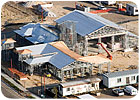
The City of San Diego is setting an example for green building by implementing eco-friendly design, construction methods and products such as steel framing to meet LEED Silver Certified requirements for municipal buildings.
A prime example, Pacific Highlands Ranch Fire Station 47, is currently under construction in a burgeoning residential development in suburban San Diego. It has been designed to standards that make it eligible to become the first fire station in the city to be LEED Silver certified. (The rating had not yet been awarded at the time of writing.)
“Pacific Highlands Ranch Fire Station 47 is an outstanding example of eco-friendly construction, strong community building focus and suitable amenities,” said Larry Gleason, a facilities maintenance officer for the City of San Diego Fire-Rescue Department.
Plans for the 10,500-square-foot facility were made to suit 11 personnel by including individual sleeping quarters and living amenities, three drive-through apparatus bays, an exercise room, a locker room and more.
Knowing the standard requirements of any new municipal building, such as energy efficiency and structural integrity, Gleason had one additional necessity for this fire station.
“I asked the architect to build it as if we were building a fraternity house that needs to stand at least 50 years,” Gleason said. “Because in all seriousness, it has to be a tough building inside and out to handle the work firefighters do.”
Steel Frames the Way for Silver
The building’s future tenants initially requested a masonry structure, but were open to suggestions that would lead to an increase in LEED points.As an experienced architect, G.V. Salts, owner of STK Architecture in Temecula, Calif., firmly grasps the importance of “greenness” and durability. He has designed more than 50 fire stations in California and thus understands the special needs and restrictions associated with constructing municipal buildings. To provide the best results for this client, Salts and STK Architecture’s LEED AP Project Manager Christina Grade presented a cost/benefit analysis that clearly displayed the numerous benefits of steel framing for both municipal and green buildings.
For example, steel framing is a 100 percent recyclable material, requires less overall building material and labor, and opens the door to earn more LEED credits.
Salts and Grade recommended and used Dynastructure, a cold-formed steel framing system manufactured by Allied Tube & Conduit in nearby Ranch Cucamonga, Calif. An innovative tubular framing system with integrated stud and track, the system facilitates fast, cost-efficient, and earthquake and fire-resistant structural installations of essential, school, franchise, retail and other facilities.
Steel Brings Strength and Speed
The components of the recommended framing system were precision fabricated using light-gauge, square tubular steel and “C” channel steel elements pre-drilled to precise measurements and welded in a tight-tolerance jig, all of which appealed to Gleason’s needs. The wall panels (with door and window openings), trusses and roof panels were then delivered to the site ready to bolt together. The simplicity of this particular pre-engineered steel system allows buildings to be framed as much as five times faster and at lower cost than masonry, standard light-gauge or wood framing.“With fire stations, both the cost-effectiveness and durability of each structure is vital. It is important to us and our clients that taxpayers’ money goes to good use,” said Salts.
For Pacific Highlands Ranch Fire Station 47, using Dynastructure also resulted in additional LEED credits for being a local/regional product with high post-consumer recycled content, reduced the total construction timeline by approximately 2.5 months, and thus far has saved at least $262,500 in overall construction costs.
“Along with the system’s many strengths, cost and green merits, it also allows the design flexibility to ‘trick’ the building out to meet the needs of a modern fire station while adhering to the early California Mission style required to blend with the community’s aesthetic,” added Grade.
Steel Supports Green
Because it is steel, the fire station’s frame is not only recyclable, but also resists fire, pests and mold. To ensure and enhance thermal efficiency, the framing has been wrapped in an exterior insulation finish system (EIFS) as well as foil-lined sheathing on the roof to create a radiant barrier.Other design features such as low e-glazed windows and innovative solar collectors, in addition to an EIFS and clay tile cool roof, are also expected to reduce the building’s energy usage significantly.
“Overall, the energy models show that the station will save 35 percent more energy than a standard California building. When compared to buildings outside of California, it will see an estimated 45 percent more energy savings per the ASHRAE/IESNA Standard 90.1-1999,” said Grade.
The attention to green building practices will pay off beyond the rewarding experience of being environmentally sensitive. According to the U.S. Green Building Council, an upfront investment of a 2 percent premium in construction costs in green building designs results in savings of 20 percent over the lifecycle of the building – that’s 10 times more than the initial investment.
When completed in November 2007, Pacific Highlands Ranch Fire Station 47, with its white towers and arches, will easily fit into the style of its new neighborhood.
“Most important, it will help San Diego continue to set an example for municipal green building in Southern California,” concluded Gleason.

Report Abusive Comment